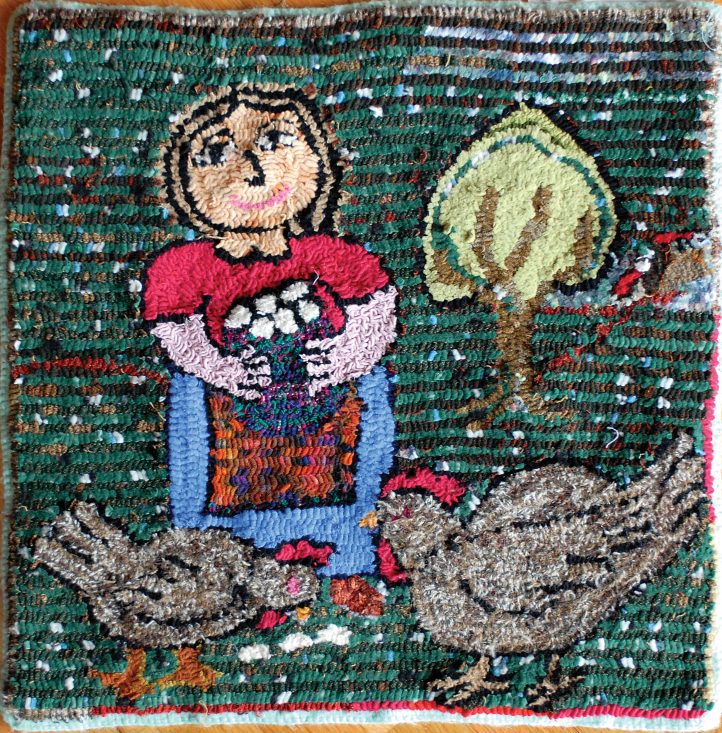
Photography By Charlotte Bell
Gathering Eggs by Silvia Ramirez
In Mexico when you meet a friend after a long absence, you say, “Que Milagro,” which means, “What a miracle.” When I first heard this I didn’t understand. “Meeting friends is a miracle?” I soon learned that this greeting, both simple and profound, is a portal into understanding a bit of the mysterious Mexi-can soul. As we look at the story of how rug hooking came to Mexico, we see that it is nothing short of miraculous.
In the mid-1990s a group of expats in San Miguel de Allende (SMA) were searching for ways to help local impoverished women. Ted Mclaughlin, a Canadian antiques dealer, suggested rug hooking, perhaps thinking of the success of Grenfell rugs. Little did he know that within 15 years rug hookers from all over Canada and the US would be donating carloads of wool and supplies and purchasing the rugs hooked from those supplies, bringing thousands of dollars a year to the people in the small village of Agustin Gonzales.
Mujeres en Cambio (MEC) was launched from that conversation. Their purpose was twofold: First, to provide scholarships for girls since public education is not free in Mexico. Second: To teach a profitable craft to rural women, thus increasing their families’ income. Local artist Gerry Gill offered to teach the first rug hooking classes. Pakina Lan-gensheidt, the mayor’s wife, arranged for a classroom, and with this small beginning rug hooking landed in Mexico.
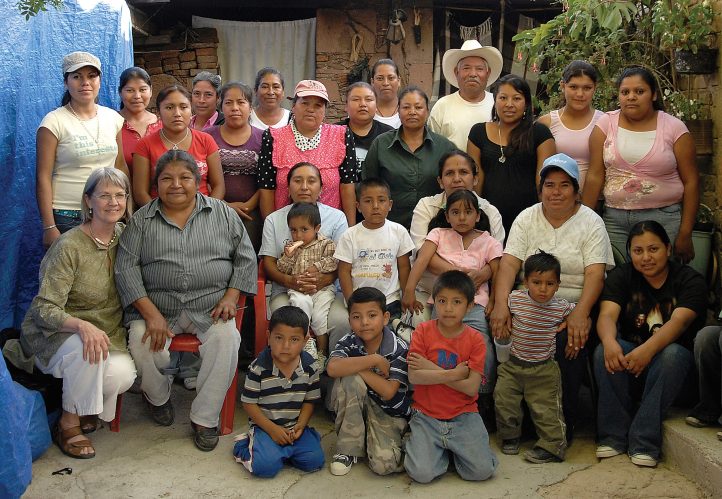
Rug hookers in the community
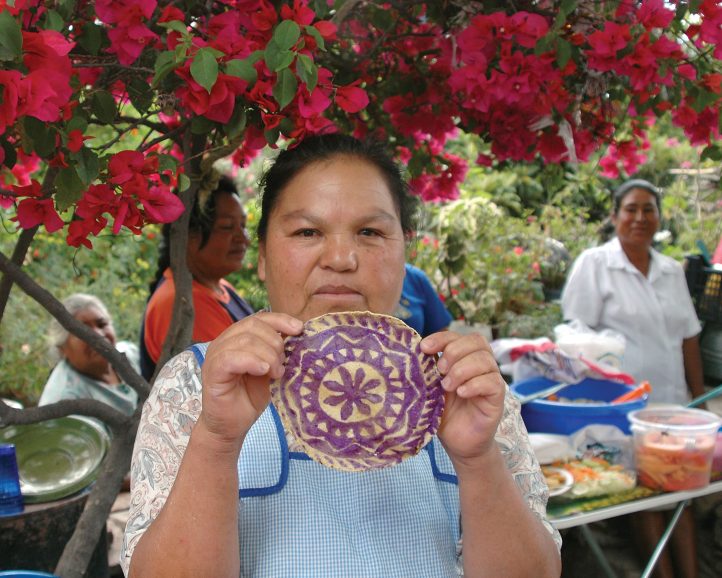
Petra “Grande” Rameriz holds a decorated torilla
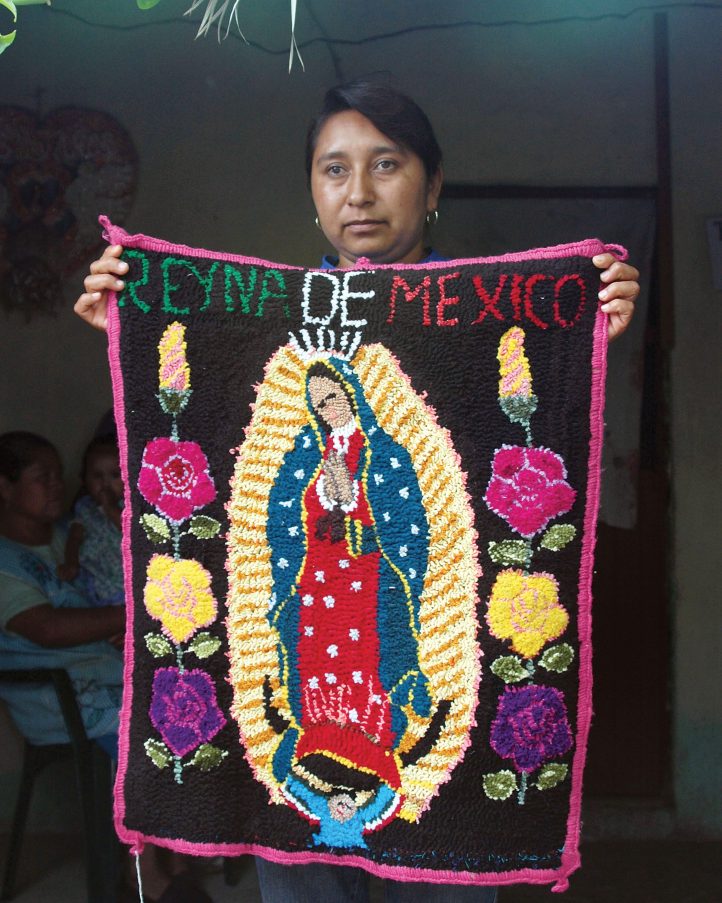
Bonifacia Tovar holds her rug, The Virgin of Guadalupe
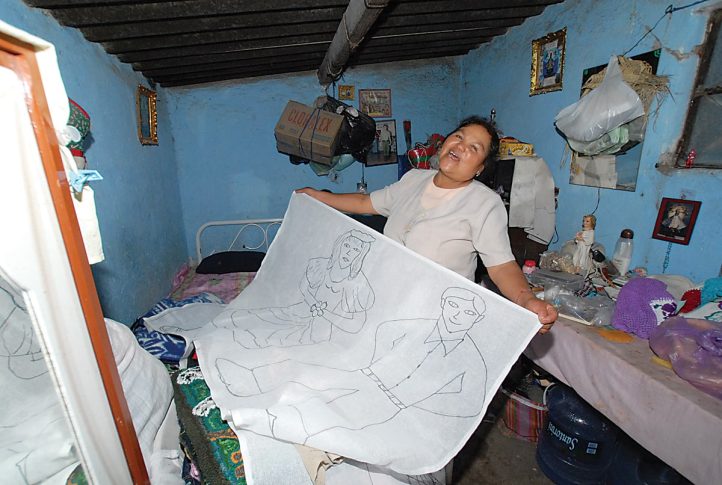
Petra “Grande” shows a rug drawing in her home
During the first few years, rugs were sold at the MEC luncheons, but sales were very slow. I am a photographer, and in 2000 I became involved because I was taking photos of the women for a website I was creating for MEC. During that visit, my friend, Susan White, bought all their rugs, $800 worth, for her folk art store in Austin, Texas. The women were flabbergasted. They had never sold that many rugs or made that kind of money before in their lives! But it didn’t stop there: we showed the rugs to the famous Las Manitas restaurant in Austin. The owners loved the rugs, so every fall for five years I brought back a collection of rugs for them. The rugs would grace the walls of the restaurant during December, and sales were good. I began showing rugs at the Christmas fairs in Austin. People everywhere were charmed by their unsophisticated designs. (Note: I do not make personal profit from any sales.)
The real miracle began in 2004 with this very magazine. An article in the January/February issue of RHM about the project had an amazing effect. First there were rug sales. Then there were calls from women around the USA and Canada who wanted to help. They sent wool, hooks, cutters, and more and more wool. The Brandywine, Pennsylvania, rug hookers asked for rugs to sell at their yearly rug camp.
Then Barbara Hanson called from Hillsboro, Oregon. She arranged for a real art gallery showing at the Glen Viola Cultural Art Center in Hillsboro. The walls of the center were covered with rugs and I presented a slide show and talk. I continued to receive emails, calls, and donations. People visiting SMA wanted to visit the village and buy the rugs.
In 2008, Barbara organized the first “Rug Hooking Knows no Borders” rug camp in San Miguel. A highlight of the camp was a trip to the village. Forty campers sat side by side with their Mexican counterparts, all hooking together. Bea Brock, one of the teachers, asked the women where they got their inspiration. Some of these women can barely read or write but that has nothing to do with their intelligence or creativity. One of the women, Pueblito, told of being overcome by the green of summer and so she made a rug with lots of green; Anselma mentioned gazing at the night sky, which inspired a rug of dark blue with white shining stars.
So that you can fully appreciate this project, let me describe the village of Agustin Gonzales. Typical of thousands of villages in Mexico, it is 6500 ft. above sea level, 14 miles from SMA in the central Mexican mountains. The climate is semi-arid, and the 100 families living there are subsistence farmers. They grow their own food, mostly corn, beans, and squash. A typical day begins with grinding dried corn into masa with a stone matate. The masa is flattened into tortillas, the staple of their diet, which are cooked on a fire. Into these tortillas they fold beans and nopal cactus. If the family has goats or chickens, cheese or eggs are added to the tortillas. They don’t have any cash for the extras, like bus money, toilet paper, school expenses, clothing, electricity, and—that most important item—seed for crops. Meat is a luxury, as are doctor and dentist visits, pain medication, first aid materials, and a thousand other things we take for granted.
Most of the women in the group are married and their husbands work as farmers. Some men work in construction in SMA, where they make from $75 to $120 per week. With the current economic crisis, many jobs are gone. Men frequently go to the USA for work to support their families. They often have no choice.
Now we come to rug hooking. Imagine what it must be like for a woman to make the decision to stay home with her children to make a rug that will sell for$65. This is a miracle: in one sale she can earn almost what her husband earns in a week. Imagine now what happens when a woman sells many rugs, or one big rug for $500 US. This is the equivalent of a month’s wages from her husband. Rug hookers in the USA and Canada donated the wool, so her expenses are minimal. Imagine as she enters her small two-room house with its one light bulb and has this kind of money in her hand. I know they pray to their saints for help, but I know they also give thanks to their hooker sisters north of the border who bought their rugs.
Medical issues are the single largest burden for impoverished people. For example, Oralia’s son is in remission for leukemia. Twice yearly they travel by bus to the clinic in Leon, an hour away, for tests. Petra’s husband was handicapped years ago from a spinal injury suffered in a car wreck, so she is the sole supporter for her family. Boni’s brother, who was the farmer of the family, broke his leg and after two years still cannot do the rigorous work of plowing the fields with oxen. In Mexico if you do not have the money up front for medical treatment, you do not receive it. But the miracle of money from rugs sales is saving the day.
The challenge? Continued sales. This is my constant concern. I know these people can continue to make their way in the world without our help—they have lived through some very tough times. But this is a great opportunity for them to have a better life.
We’ve seen a marketing miracle through rug sales at camps and hook-ins. Here’s how it works: I send a collection of rugs to the camp. They sell rugs, and send the unsold rugs back to me. The money goes to the women in Agustin Gonzales. I look at the huge list of rug hooking groups around the country and think of the potential. Will other camps get involved with this project? The success so far is due to an expanding circle of interested people.
The dream? Currently there are 21 rug hookers in the village, but the entire village could get involved. With more sales and creative ideas for related products, it is possible. Rug hooking could impact the entire community of over 1000 people: Men would not have to go north. Families could stay together.
There must be something about rug hooking that attracts people with big hearts. However, analyzing why this miracle is happening is beyond me. I simply say, “Gracias a Dios.” Thank God for rug hookers, for they are making a huge impact on a small village in the middle of Mexico.
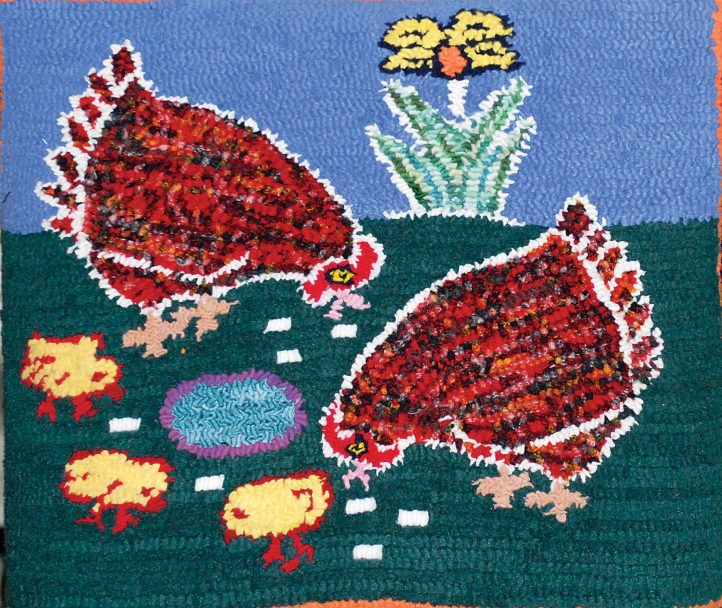
Gallinas y Politos, by Isabel Rameriz
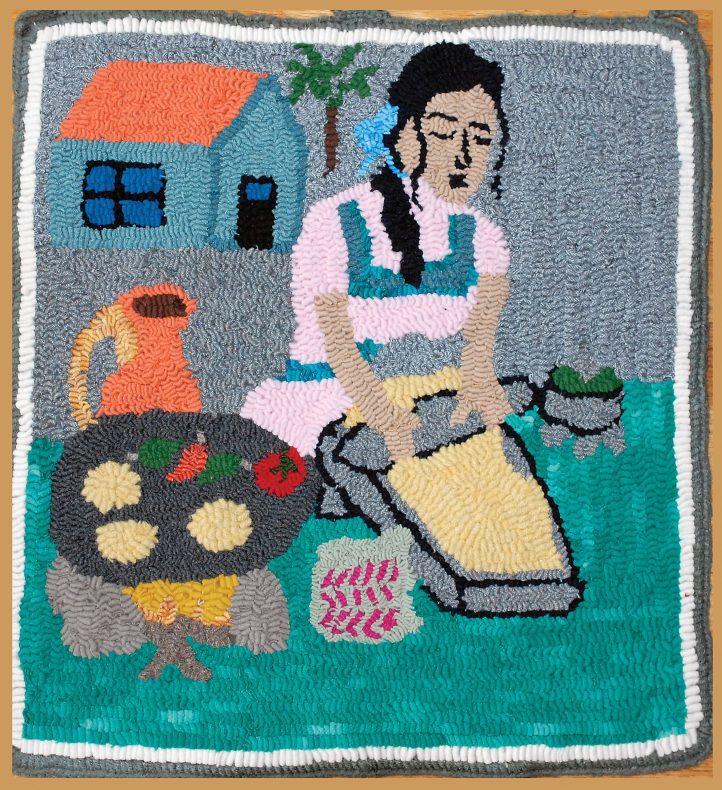
Making Tortillas, by Silvia Hernandez.
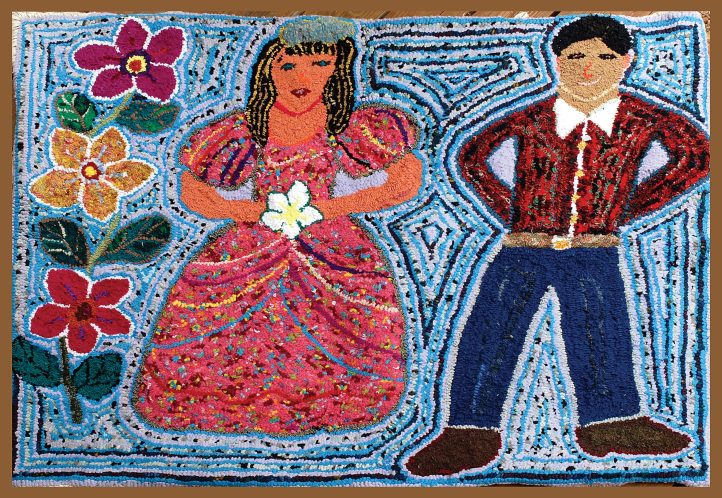
Quinceanero, by Petra “Grande” Rameriz.
Shows and Camps
Listed here are some of the events which showcased the rugs:
- Instituto Allende Craft Fairs, Direct sales from Las Rancheritas, San Miguel de Allende, MX
- Travis Heights Art Trail, Austin, TX. Charlotte Bell, organizer
- Rug Exhibit: Woodenville, WA. Joan Sample and group, organizers
- Hopkins Rug Artist Spring Hook In, Hopkins, MN. Bette Buelow and group, organizers. The hookers of Hopkins, Minnesota challenge other rug camps to have exhibitions at their hook-ins. “Let’s keep the magic going!”
- TIGHR Conference, 2009 Louisville, KY. Susan Feller, organizer
- ATHA Conference, 2009 Louisville, KY. Mary Silva, organizer
- Brandywine Hook-in, Brandywine, PA
- Rock Creek Hook-in, Lenexa, KS. Marilyn Schmidt, organizer
- Orange Coast Classic, Anaheim, CA. Sally Coon, organizer
- Yellow Rose Rug Camp, Salado, TX. Susan Harper, organizer
